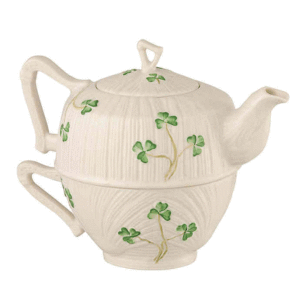Belleek pottery is known for being Irish, and a lot of people know the famous pieces that contain tiny shamrocks on the surface of the delicate porcelain.
Belleek has a distinctive Irish history, rich in trial and error.
Belleek started when John Caldwell Bloomfield inherited the family property and estate in the small town of Belleek, in Northern Ireland, on the River Erne.
Seeking to help his workers and tenants overcome the Irish potato famine, Bloomfield ordered geological surveys of his land and found it to be rich in minerals.
This was a perfect fit to begin a pottery operation, something that was very lucrative at the time in Europe.
He fancied himself an amateur mineralogist, and was fascinated by chemical interactions.
1858 saw a railway line built to Belleek, promoted by Bloomfield, in the local town in which the pottery was to be named.
Knowing this could be costly, he obtained a few business partners.
Coal had to be brought into Belleek to fire the massive kilns that would turn clay into porcelain, and this railway line provided the necessary equipment and supply.
Belleek started with domestic home products, but started producing more and more porcelain decorative items as well.
Belleek came to be known for something called Parian porcelain, which is porcelain imitating marble, and is also known for the thin, delicate nature of porcelain.
Belleek is also well known for one style with shamrocks, that seems to represent Ireland and Irish porcelain.
Also, too, Belleek was known, and still is, for the translucent, delicate nature of their porcelain.
When held up to the light, one can almost see through it, yet it is durable.
It began to spread in popularity, and by 1865, it was being bought and sold to Australia, Canada, England, and of course the United States.
Nobility also favored the delicate porcelain, which helped sales.
Standards of the porcelain quality were set extremely high during this period.
It is said cartloads of inferior specimens would be tossed if they did not meet the exacting standards of a team of acquired, talented artists, recruited to the company to make the best porcelain in the world.
Belleek changed hands many times through the years after the original staff passed away completely by the late 1800s.
It was named Belleek Pottery Works Company Ltd. by local investors of the time who purchased the rights to the company, and would change hands a few more times over the years.
During this time period, they expanded their lines and offerings.
In both World Wars, as with many European manufacturing companies, Belleek struggled for use of materials, and made earthenware to survive during hard manufacturing periods.
Supplies were needed for war, and acquisition of such materials was difficult.
They eventually went back to firing their coal kilns when supply came back, and went to electric kilns in the 1950s.
The company has changed hands several times over the years, and today is owned by Dundalk native George G. Moore and run by several directors.
It has subsidiary companies and has more than present-day 600 employees.
The company website boasts production of more than 100,000 items produced annually.
It is still known for the delicate, paper thin porcelain and the tiny shamrock pattern — just one of many patterns the company produces.
Irish eyes smile upon the history of the company, from the Irish potato famine to current trends in Irish pride and roots.
(Editor’s note: DeeDee Wood is the owner of Black Cat Curiosities Art and Antiques in Easton, Md., located at 24B Harrison St.)



